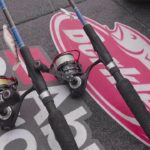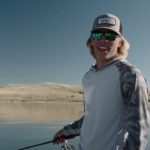Downsize for Early Season Muskies? Not Necessarily”¦
Rob Kimm of Esox Angler Magazine originally penned this article for Minnesota Outdoor News.
 One of the standby pieces of advice most muskie anglers have heard over and over is: early in the season, it’s necessary to downsize your presentation. The reasons given for the necessity to use smaller lures early are various, and range from the somewhat reasonable (cooler water makes muskies less aggressive) to the flat-out illogical (most of the forage is small in the spring, so lures should ‘match the hatch’ and be small in size. Last fall it was ‘use big lures because the forage is all big’ and 10 inch lures were the standard. Did all the baitfish shrink over the winter?). Whatever the justification, downsizing by default is a rule of thumb many early season muskie anglers swear by.
One of the standby pieces of advice most muskie anglers have heard over and over is: early in the season, it’s necessary to downsize your presentation. The reasons given for the necessity to use smaller lures early are various, and range from the somewhat reasonable (cooler water makes muskies less aggressive) to the flat-out illogical (most of the forage is small in the spring, so lures should ‘match the hatch’ and be small in size. Last fall it was ‘use big lures because the forage is all big’ and 10 inch lures were the standard. Did all the baitfish shrink over the winter?). Whatever the justification, downsizing by default is a rule of thumb many early season muskie anglers swear by.
In reality though, unless specific on the water conditions justify it, going small is often a big mistake.
Using standard-size lures right out of the gate can make sense for a number of reasons:
Water temperature – Minnesota’s muskie season starts relatively late compared to Wisconsin, where it seems the ‘go small’ rule of thumb originates. The extra week between openers can make a significant difference in water temperatures, and on smaller to mid-size Minnesota muskie lakes, surface temperatures in the high 60s to low 70s aren’t uncommon given decent weather.
Attracting ability – Early season muskies are often in transition between spawning areas and summer habitat. For anglers, this means searching flats such as developing weedbeds, shallow sand and sandgrass flats, or even bare sand shorelines, in search of roving muskies. Covering large flats effectively requires lures that are able to call fish in from a distance. Larger lures such as standard size-bucktails, large, flashy twitch baits such as 10 inch Musky Mania Jakes, Musky Innovations’ Shallow Invaders, or full-size jerkbaits have the mass, sound and flash to call fish. They simply cover more water per cast than smaller lures can.
Open water – Away from the flats, targeting muskies keying on open water forage such as ciscos also calls for larger lures. Early season, before lakes stratify and thermoclines develop, is one of the best opportunities of the season for open water muskies, and an option many anglers overlook. Much like the flats, fishing open water areas effectively requires lures that can call fish in from a distance, as well as stand out from the crowd of other food options. Aggressively twitching large crankbaits, such as Jakes and Esox Research Company Triple-Ds, or trolling 10 inch Believers through and around schools of open water forage, is an effective way to target open water fish, while smaller lures may not get noticed.
Triggering ability – While early season muskies are certainly catchable, it’s often the case that they’re just not cranked into quite as a high a gear as they may be in a few week’s time when the water’s warmer and they’ve settled into a more stable summer routine. For early season anglers, a day on the water with lots of follows and few strikes is a fairly common outcome. The challenge for anglers is finding ways to trigger strikes from fish that are interested, but not actively feeding. There are a variety of strategies for triggering fish, such as highly erratic baits, speed (which we’ll get to in a bit), or far-out color combinations. One of the most effective though is sheer size. A large – even grossly outsized – presentation can trigger reaction strikes from fish that may only follow smaller lures. Large, slow moving topwaters such as Hawg Wobblers, creeper-style baits, or large bucktails and spinnerbaits bulged over developing weeds can be good options to throw back to fish that have followed other lures but refused to strike.
There are plenty of cases where downsizing can be the wrong move. So when is it the right choice for early season muskies?
For me, I’ll make the decision based on the same criteria I’d use later in the season. In other words, if confronted with the same conditions – weather, water conditions, fish activity, etc., in August, would I choose to downsize my presentation? If I’d do it then, I’d do it now too:
Cold fronts – Particularly in early season when fish activity is iffy anyhow, the Mother of All Cold Fronts can really sock fishing in the nose. Downsizing from standard size muskie baits to smaller lures, or even large bass lures, can help deal with difficult conditions. Small twitch baits, worked with short twitches and long pauses, or small spinnerbaits slow rolled along inside turns or through developing weedbeds can salvage a tough day.
Speed – Triggering fish was mentioned above, and one of the most effective triggers is often pure speed. Burning small bucktails over the flats, fast, erratic twitch baits like Bomber Long-As or Mann’s Stretch 1-minus, or fast-moving topwaters like bass-style buzzbaits can trigger reaction strikes from fish that may only follow slower baits.
Rapidly rising water temperature – Warming trends are usually good news early in the year, but rapidly warming water can be too much of a good thing. Sharp rises in water temperature can negatively effect fish activity every bit as severely as sudden temperature drops associated with passing cold fronts, and fish react to both sets of conditions much the same. Counter spikes in water temperatures with the same techniques you’d use in a severe cold front.
The ‘Ouch’ Factor – This is certainly more of an early season specific situation, but it’s a reality. Casting muscles get out of shape over the winter, and blasting away with big baits right out of the gate can have you diving for the Advil in a hurry. If the easier physical load of smaller baits keeps you casting instead of resting, by all means, downsize. Baits, whatever size they are, only work when they’re in the water.
When you get out after early season muskies this year, don’t leave the big baits at home. Downsizing by default can be a big time mistake.





